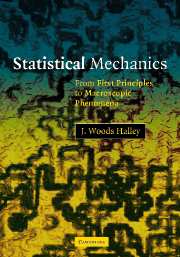Book contents
- Frontmatter
- Contents
- Preface
- Introduction
- Part I Foundations of equilibrium statistical mechanics
- Part II States of matter in equilibrium statistical physics
- Part III Dynamics
- 10 Hydrodynamics and definition of transport coefficients
- 11 Stochastic models and dynamical critical phenomena
- Appendix: Solutions to selected problems
- Index
11 - Stochastic models and dynamical critical phenomena
Published online by Cambridge University Press: 05 June 2012
- Frontmatter
- Contents
- Preface
- Introduction
- Part I Foundations of equilibrium statistical mechanics
- Part II States of matter in equilibrium statistical physics
- Part III Dynamics
- 10 Hydrodynamics and definition of transport coefficients
- 11 Stochastic models and dynamical critical phenomena
- Appendix: Solutions to selected problems
- Index
Summary
General discussion of stochastic models
In the hydrodynamic theories, one writes equations which describe the system at hand on long time and length scales, using local conservation laws and the presence of broken symmetries to determine the identity of these slowly varying quantities. However, one would like a way to take account of the effects of the more rapidly varying degrees of freedom in such theories. Implicitly, these more rapid degrees of freedom are present in the integrals which determine the transport coefficients in the hydrodynamic equations by way of Kubo relations, but no method is presented to calculate the required integrands. One way to take account of the other degrees of freedom is to take on the entire many body problem all the way down to the atomic or electronic level, as one does in molecular dynamics simulations of various sorts. However, it is useful to have some approximate analytical ways to attack this problem as well. Here we review the basis for the most common such approach, the Langevin equation. For most of this discussion, we will assume that the identity of the slow variable or variables is known and that the separation of time scales is extreme so that the faster variables are essentially instantaneous in a sense we will discuss. These assumptions are not often particularly well justified. However, the resulting formulation has yielded very useful insights and is an important part of the subject.
- Type
- Chapter
- Information
- Statistical MechanicsFrom First Principles to Macroscopic Phenomena, pp. 217 - 242Publisher: Cambridge University PressPrint publication year: 2006

